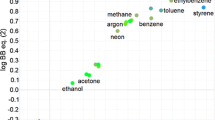Summary
The head space method for determination of tissue-gas partition coefficients was modified to make it suitable for determination of tissue-gas partition coefficients of water soluble solvents. The method was used to determine tissue-gas partition coefficients of acetone, 2-butanone, methanol, ethanol, 1-propanol, 2-propanol and isobutanol for six representative tissues (muscle, kidney, lung, white and gray matter of brain, and adipose tissue). Blood-gas partition coefficients and distribution between plasma and erythrocytes were also determined. Relation between tissue-blood and fat-blood partition coefficients of 35 hydrophilic and hydrophobic substances of different chemical structure is described by linear correlation equations which can be used for prediction of tissue-gas partition coefficients of any chemical for which blood-gas and fat-gas partition coefficients are known. The correlation equations are based on all currently available data.
Similar content being viewed by others
References
American Conference of Governmental Industrial Hygienists, Inc. TLV® threshold limit values for chemical substances and physical agents in the work environment. Cincinnati, Ohio, 1984–85
Castleman B (1974) Normal laboratory values. New Eng J Med 290:39–40
Dueck R, Rathbun M, Wagner PD (1978) Chromatographic analysis of multiple tracer inert gases in the presence of anesthetic gases. Anesthesiology 49:31–36
Fink BR, Morikawa K (1970) A simplified method for the measurement of volatile anesthetics in blood by gas chromatography. Anesthesiology 32:451–455
Fiserova-Bergerova V (1983) Gases and their solubility: A review of fundamentals. In: Fiserova-Bergerova V (ed) Modeling of inhalation exposure to vapors: uptake, distribution, and elimination vol. 1. CRC Press, Boca Raton, Fl, pp 3–28
Fiserova-Bergerova V (1985) Toxicokinetics of organic solvents. Scand J Work Environ Health 11 [Suppl 1] 7–21
Fiserova-Bergerova V, Kawiecki RW (1984) Effects of exposure concentrations on distribution of halothane metabolites in the body. Drug Metab Dispos 12:98–105
Fiserova-Bergerova V, Tichy M, Di Carlo FJ (1984) Effects of biosolubility on pulmonary uptake and disposition of gases and vapors of lipophilic chemicals. Drug Metab Rev 15:1033–1070
Kamlet MJ, Abraham MH, Doherty RM, Taft RW (1984) Solubility properties in polymers and biological media. 4. Correlation of octanol water partition coefficients with solvatochromic parameters. J Am Chem Soc 106:464–466
Lowe HJ (1972) Dose-regulated penthrane® methoxyflurane anesthesia. Abbott Laboratories, North Chicago, II
Perbellini L, Brugnone F, Caretta D, Maranelli G (1985) Partition coefficients of some industrial aliphatic hydrocarbons (C5–C7) in blood and human tissues. Br J Ind Med 42:162–167
Pezzagno G, Ghittori S, Imbriani M, Capodaglio E (1982) The measure of solubility coefficients of gases and vapours in the blood or other fluids. I. The methods. G Ital Med Lav 4:251–261
Pezzagno G, Ghittori S, Imbriani M, Capodaglio E (1983) The measure of solubility coefficient of gases and vapours in blood. II. The largely used industrial solvents. G Ital Med Lav 5:49–63
Sato A, Nakajima T (1979) A structure-activity relationship of some chlorinated hydrocarbons. Arch Environ Health 34:69–75
Sato A, Nakajima T (1979) Partition coefficients of some aromatic hydrocarbons and ketones in water, blood and oil. Br J Ind Med 36:231–234
Steward A, Allott PR, Cowles AL, Mapleson WW (1973) Solubility coefficients for inhaled anaesthetics for water, oil and biological media. Br J Anaesth 45:282–293
Tichy M (1983) Prediction of adverse activities from physical and chemical properties of vapors and gases (QSAR analysis). In: Fiserova-Bergerova V (ed) Modeling of inhalation exposure to vapors: uptake, distribution and elimination, Vol. II, CRC Press, Boca Raton, Fl. pp 3–35
van Rees H (1974) The partition coefficients of styrene between blood and air and between oil and blood. Int Arch Arbeitsmed 33:39–47
Wagner PD, Naumann PF, Laravuso RB (1974) Simultaneous measurement of eight foreign gases in blood by gas chromatography. J Appl Physiol 36:600–605
Young IH, Wagner PD (1979) Effect of intrapulmonary hematocrit maldistribution on O2, CO2 and inert gas exchange. J Appl Physiol 46:240–248
Author information
Authors and Affiliations
Additional information
This study was supported by NIH grant ES01029-09
Rights and permissions
About this article
Cite this article
Fiserova-Bergerova, V., Diaz, M.L. Determination and prediction of tissue-gas partition coefficients. Int. Arch Occup Environ Heath 58, 75–87 (1986). https://doi.org/10.1007/BF00378543
Received:
Accepted:
Issue Date:
DOI: https://doi.org/10.1007/BF00378543




